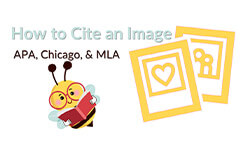
Incorporating images into your academic work can enhance your research and facilitate comprehension of your argument among readers. When citing sources, it is vital to appropriately acknowledge the source of these images to comply with copyright laws and maintain academic integrity. This article delves into the process of “citing an image” in three fundamental citation styles: APA style, Chicago, and MLA.
Definition: How to cite an image
Citing an image refers to acknowledging the source of the image that you’ve included in your work. It gives credit to the creator and helps others find the source of the image if they want to use it themselves. Additionally, citing an image avoids plagiarism and enhances your work’s credibility by showing that your information comes from reliable sources.
in Your Thesis
APA citation format
In the following subheadings, different APA citation formats of how to cite an image will be explained.
| Format: | Example: | |
| Reference entry: | Artist's Last name, First initial. Middle initial. (Year). Title of the Artwork [Description of Material]. Location. | Picasso, P. (1907). Les Demoiselles d'Avignon [Oil on canvas]. Museum of Modern Art, New York. |
| In-text citation: | (Artist's Last name, Year) | (Picasso, 1907) |
| Format: | Example: | |
| Reference entry: | Artist's Last name, First initial. Middle initial. (Year). Title of the Artwork [Description of Material]. Site Name. URL | Van Gogh, V. (1889). The Starry Night [Digital image]. Museum of Modern Art. https://www.moma.org/collection/works/79802 |
| In-text citation: | (Artist's Last name, Year) | (Van Gogh, 1889) |
Chicago style citation format
In the following subheadings, different Chicago style citation formats of how to cite an image will be explained.
| Format: | Example: | |
| Bibliography entry: | Artist's Last Name, First Name. Title of Artwork. Year. Medium, Size. Location. | Kahlo, Frida. The Two Fridas. 1939. Oil on canvas, 67 3/4 x 67 3/4 in. Museum of Modern Art, New York. |
| Footnote: | 1. Artist's First name Last name, Title of Artwork, Year. | 1. Frida Kahlo, The Two Fridas, 1939. |
| Format: | Example: | |
| Bibliography entry: | Artist's Last Name, First Name. Title of Artwork. Year. Medium, Size. Location. URL. | Monet, Claude. Water Lilies. 1916. Oil on canvas. Art Institute of Chicago. https://www.artic.edu/artworks/15285/water-lilies |
| Footnote: | 1. Artist's First name Last name, Title of Artwork, Year, URL. | 1. Claude Monet, Water Lilies, 1916, https://www.artic.edu/artworks/15285/water-lilies. |
MLA citation format
In the following subheadings, different MLA citation formats of how to cite an image will be explained.
| Format: | Example: | |
| Works cited entry: | Artist's Last name, First name. “Title of the Artwork.” Year, the Institution that Houses the Artwork, City. | Da Vinci, Leonardo. “Mona Lisa.” 1503, Louvre Museum, Paris. |
| In-text citation: | (Artist's Last name) | (Da Vinci) |
| Format: | Example: | |
| Works cited entry: | Artist's Last name, First name. “Title of the Artwork.” Website Name, Day Month Year, URL. | Dali, Salvador. The Persistence of Memory. MoMA, 02 Mar. 2021, www.moma.org/collection/works/79018. |
| In-text citation: | (Artist's Last name) | (Dali) |
FAQs
Yes, even if an image is in the public domain or copyright-free, it’s best to cite it to provide readers with the source of the image and to maintain the integrity of your research.
Include as much information as you can. If certain details like the artist’s name or the year of production are missing, just skip that part of the citation.
No, if you’ve created an image yourself (e.g., a graph, chart, or photograph), you do not need to cite it. However, be sure to label it appropriately in your work.
